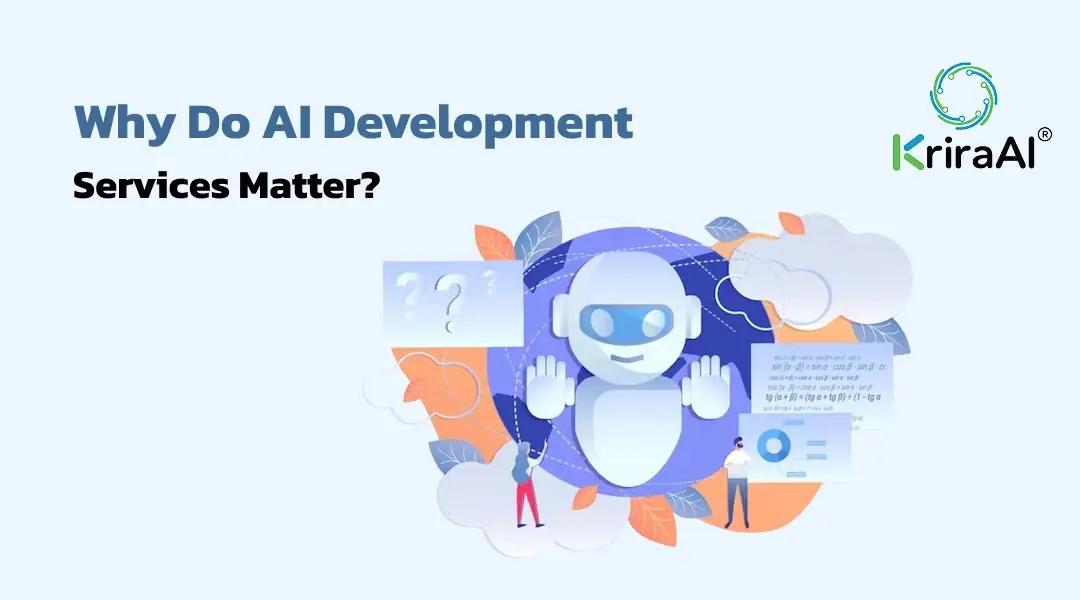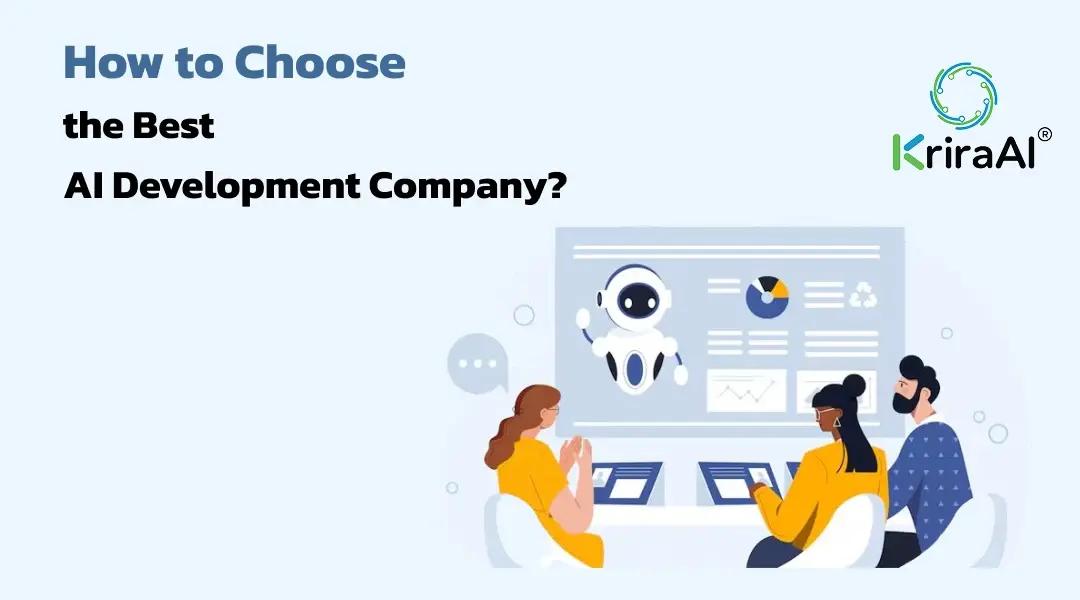Step-by-Step Guide to Implementing AI Development Services
Introduction
Let’s get one thing straight.
AI isn’t magic. It won’t automatically transform your business, lower your costs, or make your boss think you’re a genius.
But — if you implement it right — it can absolutely shift the gears of your operation into a new league.
I’m a Senior AI Consultant at KriraAI, and I’ve led projects that scaled customer service with voice agents, automated inventory prediction with ML, and even used computer vision to reduce manual inspection errors in warehouses. But I’ve also seen half-built systems rot because no one asked: “What’s the real business case here?”
If you’re here to explore AI development services seriously — not just sprinkle buzzwords into your roadmap — this guide is your map. Step by step. No fluff. Just the real stuff that makes or breaks a successful AI initiative.
Why Do AI Development Services Matter?

Let’s call it what it is: AI is no longer a “maybe.”
It’s embedded into the strategies of every company that wants to stay relevant — from startups automating onboarding to enterprises optimizing logistics routes in real time.
The global AI software market is projected to hit $305 billion by 2026. But more important than the market size? The widening gap between companies who know how to implement AI right… and those still in “let’s try something cool” mode.
AI development for business isn’t about showing off. It’s about outcomes. Speed. Personalization. Cost efficiency. And if your business isn’t already investing in it, your competitors probably are.
Pre-Implementation Planning: Laying the Groundwork
Before any code gets written, ask the hard questions:
What business outcome are we solving for?
Do we have access to relevant, clean data?
Who’s owning the implementation — product, tech, or ops?
What’s the timeline and budget tolerance?
Without this clarity, even the best AI development company will fumble. That’s how AI deployment challenges happen — scope creep, feature bloating, and ultimately… failure.
Step 1: Define the AI Use Case Clearly
This is where many businesses get stuck. They come in wanting “AI,” but can’t articulate whether they need:
NLP for automating customer support
Computer Vision (CV) for defect detection
Predictive models for sales forecasting
Recommendation systems for e-commerce
Don’t build a model. Solve a problem. And make sure the use case aligns with your business objectives, not just what’s trendy.
Step 2: Choose the Right AI Development Partner
Here’s the uncomfortable truth: most agencies claiming to be “the best AI company” are just riding the wave. They’ll throw together a few Python scripts, slap “AI” on it, and call it innovation.
You need someone who gets:
The AI development process
Your industry context
Integration realities (not everything fits into a fancy dashboard)
At KriraAI, we’ve turned down projects that didn’t make sense — because pushing a doomed idea helps no one.
When vetting partners, ask for:
Real-world AI implementation examples
Their approach to custom AI development
Who’s actually building the model (not just managing the project)
Step 3: Data Collection & Preparation
Garbage in, garbage out. You’ve heard that before — but in AI, it’s gospel.
Great AI starts with quality data:
Cleaned
Structured
Labeled
Relevant
We’ve spent months with clients just organizing data before writing a single line of model code. That’s not a delay — that’s insurance.
If you're skipping this, you're building on sand.
Step 4: AI Model Development & Training
Now we’re in the engine room.
Do you use a pre-trained model and fine-tune it for your needs? Or do you build a custom model from scratch using a framework like TensorFlow, PyTorch, or Hugging Face?
There’s no one-size-fits-all. A logistics company might need a custom route optimization model. An e-commerce brand could thrive using off-the-shelf recommendation algorithms — if integrated correctly.
This is where AI software development earns its reputation — and where hiring the right experts pays off.
Step 5: Testing, Validation & Iteration
Please — please — don’t ship the model just because it hit 92% accuracy in a sandbox.
You need real-world validation:
Does it work on live data?
How does it perform under edge conditions?
Is it explainable?
I've seen AI models that looked great in a Jupyter notebook but broke down the second they hit production traffic. Test like it’s war.
Step 6: Integration into Your Business Ecosystem
An AI model without integration is like a Ferrari with no wheels.
How does it talk to your:
CRM?
ERP?
Existing APIs?
This is where AI integration strategy becomes make-or-break.
Do it wrong, and your ops team will hate it. Do it right, and it becomes an invisible superpower in your workflows.
Step 7: Post-Deployment Monitoring & Maintenance
AI isn’t set-it-and-forget-it. It drifts. Data changes. Behavior shifts.
You need a plan for:
Retraining schedules
Performance tracking
Alerting systems for anomalies
And yes — that means budgeting for ongoing AI development services. If your partner doesn’t mention this, run.
Common Pitfalls to Avoid During AI Implementation
Let’s rip off the band-aid:
Vague goals: “We want to do AI” is not a strategy.
Overengineering: You don’t need GPT-4 for a rule-based chatbot.
Lack of internal buy-in: If ops isn’t aligned, adoption will flop.
Bad UX: An amazing model with a terrible interface is still unusable.
Ignoring explainability: Especially in regulated industries.
How to Choose the Best AI Development Company?

Spoiler: it’s not just who has the flashiest case study.
Ask:
Do they challenge your assumptions?
Can they articulate a clear AI implementation roadmap?
Will they say “no” when the idea doesn’t make business sense?
Do they offer transparency on cost, tech stack, and dev process?
You’re not just buying code. You’re buying judgment, experience, and accountability.
Conclusion
AI can absolutely transform your business. But only if you treat it like a strategic initiative — not a side project.
I’ve seen the difference between companies who implement AI versus those who experiment with it. The former get real ROI. The latter get stale slide decks and sunk costs.
If you're ready to do this right — with clear goals, strong partners, and no fluff — then AI won’t be a buzzword. It’ll be your edge.
FAQs
It varies based on complexity, but mid-range enterprise projects typically start from ₹12–35 lakh.
Define use case → choose partner → prepare data → build model → test → integrate → monitor.
Yes, especially for automation, customer service, and personalization — if done with clear ROI focus.
Poor data quality, unclear goals, integration complexity, and lack of stakeholder alignment.
A typical end-to-end project takes 3–6 months, depending on data readiness and use case scope.

CEO
